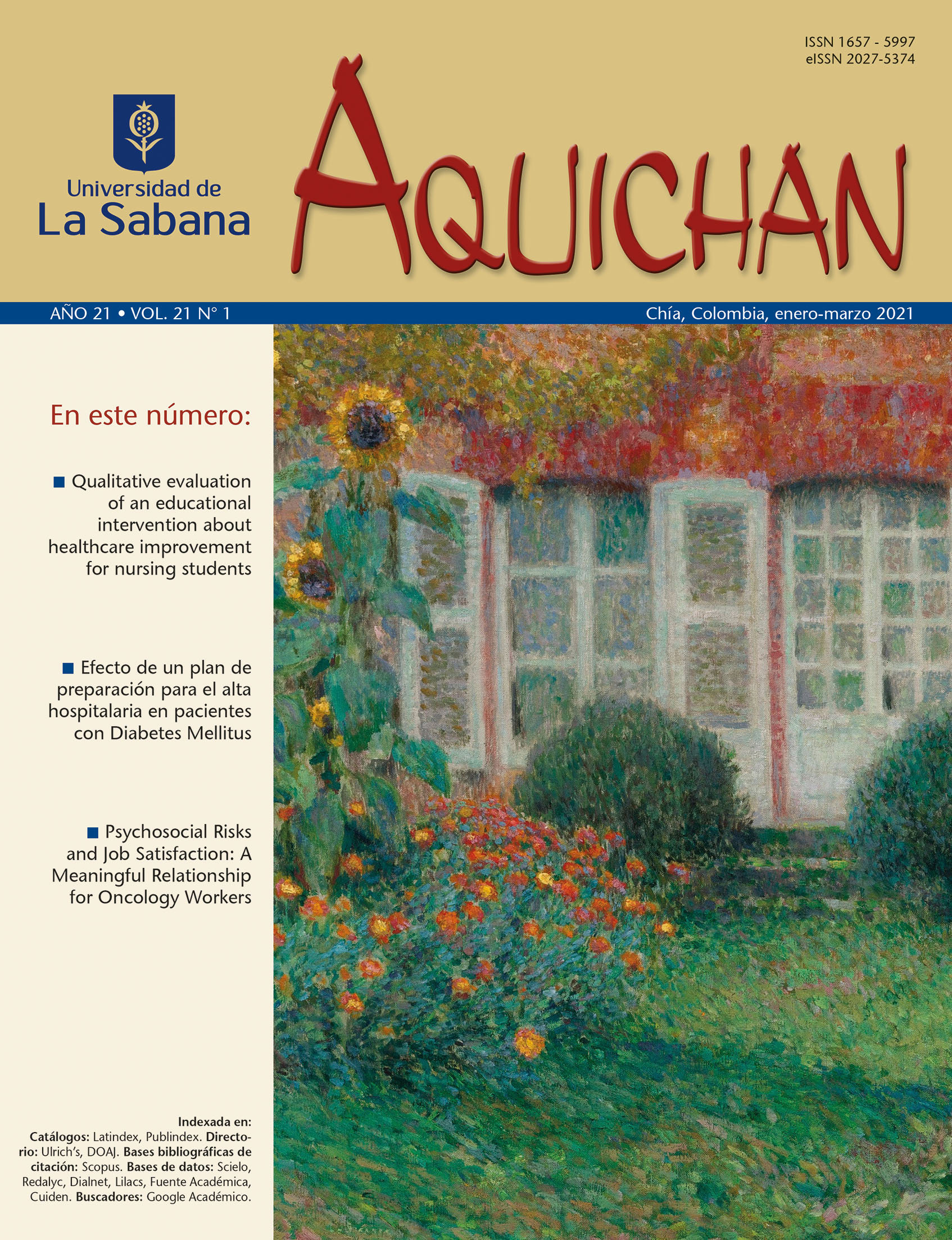Microcephaly Diagnosis: Maternal Perspectives About the Organization of the Health Care Network
DOI:
https://doi.org/10.5294/aqui.2021.21.1.7Keywords:
Microcephaly, zika vírus, nursing, delivery of health care, diagnosisAbstract
Objective: To understand the organization of the Health Care Network (Rede de Atenção à Saúde, RAS) from the experiences of mothers and family members in the assistance process for the diagnosis of microcephaly.
Materials and methods: A descriptive and exploratory research study with a qualitative approach, conducted with 14 mothers of children with microcephaly. For the definition of the sample, the following inclusion criteria were listed: being a mother of a child diagnosed with microcephaly due to Zika Virus, having given birth, and being a resident of the municipality of Mossoró, Rio Grande do Norte, Brazil. Regarding the exclusion criterion, the following was specified: mothers who did not accept to participate in the study. The population of this research was defined in 2018. Minayo’s method of thematic content analysis was employed for data analysis.
Results: The results were divided into the following categories: 1. Access to the services, exams, and professional monitoring; 2. Perception of the mothers about follow-up in the RAS. It was possible to apprehend the obstacles experienced in the RAS for the diagnosis and follow-up of children with congenital syndrome due to the Zika Virus.
Conclusions: The difficulty of operationalizing the proposed protocol for the RAS was evidenced, either due to insufficient knowledge about the syndrome, making it impossible to maintain the organizational flow established by the protocol, or to the scarcity of hard technologies that assist in the implementation of this assistance.
Downloads
References
Brasil. Portaria Interministerial n.o 405. Institui, no âmbito do Sistema Único de Saúde (SUS) e do Sistema Único de Assistência Social (SUAS), a Estratégia de Ação Rápida para o Fortalecimento da Atenção à Saúde e da Proteção Social de Crianças com Microcefalia; 2016. Disponível em: http://portalarquivos2.saude.gov.br/images/pdf/2016/marco/23/PORTARIA-INTERMINISTERIAL- N-405-MS-e-MDS-de-15.03.2016.pdf.
World Health Organization. Pregnancy management in the context of Zika virus infection. Interim Guidance Update; 2016. Available from: http://apps.who.int/iris/bitstream/10665/204520/1/WHO_ZIKV_MOC_16.2_eng.pdf?ua=1
Miranda-Filho DB, Martelli CMT, de Alencar Ximenes RA, Araújo TVB, Rocha MAW, Ramos RCF et al. Initial Description of the Presumed Congenital Zika Syndrome. American Journal of Public Health. 2016;106(4):598-600. Available from: https://doi.org/10.2105/AJPH.2016.303115
Brasil. Boletim Epidemiológico n.º 7. Brasília; 2020. Disponível em: https://www.saude.gov.br/images/pdf/2020/fevereiro/19/Boletim-epidemiologico-SVS-07.pdf
Marinho F. Microcefalia no Brasil: prevalência e caracterização dos casos a partir do Sistema de Informações sobre Nascidos Vivos (Sinasc), 2000-2015. Epidemiologia e Serviços de Saúde. 2016;25(4):701-12. DOI: https://doi.org/10.5123/s1679-49742016000400004
Governo do Estado do Rio Grande do Norte. Boletim Epidemiológico: Semana 7/2020. Natal; 2020. Disponível em: http://www.saude.rn.gov.br/Conteudo.asp?TRAN=ITEM&TARG=96506&ACT=&PAGE=&PARM=&LBL=MAT %C9RIA
Brasil. Protocolo de vigilância e resposta à ocorrência de microcefalia e/ou alterações do sistema nervoso central (SNC). Ministério da Saúde; 2016. Disponível em: http://portalarquivos.saude.gov.br/images/pdf/2016/marco/24/Microcefalia-Protocolo-vigil--ncia-resposta-versao2.1.pdf
Minayo, MCS (org.). Pesquisa Social. Teoria, método e criatividade. 21. ed. Petrópolis: Vozes; 2002. Disponível em: https://wp.ufpel.edu.br/franciscovargas/files/2012/11/pesquisa-social.pdf
Ment LR. Practice parameter: Neuroimaging of the neonate. Neurology. 2002;58(12):1726-38. DOI: https://doi.org/10.1212/wnl.58.12.1726
Brasil. Atenção ao pré-natal de baixo risco. Ministério da Saúde; 2013. Disponível em: https://aps.saude.gov.br/biblioteca/visualizar/MTIwOQ==
Nunes, TS, Abrahão, AR. Repercussões maternas do diagnóstico pré-natal de anomalia fetal. Acta Paulista de Enfermagem. 2016;29(5):565-72. DOI: https://doi.org/10.1590/1982-0194201600078
Mossoroense J. Sesap realiza mutirão de atendimento às crianças com microcefalia em Mossoró e região; 2016. Disponível em: https://www.omossoroense.com.br/sesap-realiza-mutirao-de-atendimento-as-criancas-com-microcefalia-em-mossoro-e-regiao/
da Silva CCB. Reações dos familiares frente à descoberta da deficiência dos filhos. Cadernos de Terapia Ocupacional da Ufscar. 2014;22(1):15-23. DOI: https://doi.org/10.4322/cto.2014.003
França TLB, Medeiros WR, Souza NL, Longo E, Pereira SA, França TBO et al. Growth and development of children with microcephaly associated with congenital Zika Virus Syndrome in Brazil. International Journal of Environmental Research and Public Health; 2018. DOI: https://doi.org/10.3390/ijerph15091990
da Silva Reichert AP. Vigilância do crescimento e desenvolvimento: análise dos registros na caderneta de saúde da criança. Cogitare Enfermagem. 2016;21(4):1-9. DOI: https://doi.org/10.5380/ce.v21i4.45256
Mestriner RG. Uma realidade revisitada em tempos de Zika vírus e microcefalia: Estamos preparados para comunicar um diagnóstico de deficiência? Ciência & Saúde. 2016;8(3):98. DOI: https://doi.org/10.15448/1983-652x.2015.3.22927
Brasil. Orientações integradas de vigilância e atenção à saúde no âmbito da Emergência de Saúde Pública de Importância Nacional. Ministério da Saúde; 2017. Disponível em: http://bvsms.saude.gov.br/bvs/publicacoes/orientacoes_integradas_vigilancia_atencao_emergencia_saude_publica.pdf
Cerqueira MMF, de Oliveira Alves R, Aguiar MGG. Experiências vividas por mães de crianças com deficiência intelectual nos itinerários terapêuticos. Ciência & Saúde Coletiva. 2016;21(10):3223-32. DOI: http://dx.doi.org/10.1590/1413-812320152110.17242016
Garcia LP. Epidemia do vírus zika e microcefalia no Brasil. Brasília: Instituto de Pesquisa Econômica Aplicada; 2018. Disponível em: https://www.ipea.gov.br/portal/index.php?option=com_content&view=article&id=32492.
Brasil. Plano de Resposta às Emergências em Saúde Pública [internet]. Brasília: Ministério da Saúde; 2014. Disponível em: http://bvsms.saude.gov.br/bvs/publicacoes/plano_resposta_emergencias_saude_publica.pdf
Hasue RH. A síndrome congênita do vírus Zika: importância da abordagem multiprofissional. Fisioterapia e Pesquisa. 2017;24(1). Disponível em: https://www.scielo.br/scielo.php?pid=S1809-29502017000100001&script=sci_arttext
Montenegro LC. A integralidade sob a ótica dos profissionais dos Serviços de Saúde de Belo Horizonte. Revista da Escola de Enfermagem da USP. 2010;9(44):649-56. Disponível em: http://www.scielo.br/scieloOrg/php/articleXML.php?lang=ptpid=S0080-62342010000300014.
Downloads
Published
How to Cite
Issue
Section
License
Copyright (c) 2021 Aquichan

This work is licensed under a Creative Commons Attribution-ShareAlike 4.0 International License.
1. Proposed Policy for Journals That Offer Open Access
Authors who publish with this journal agree to the following terms:
- The journal and its papers are published with the Creative Commons License Attribution-NonCommercial-NoDerivatives 4.0 International (CC BY-NC-ND 4.0). You are free to share copy and redistribute the material in any medium or format if you: give appropriate credit, provide a link to the license, and indicate if changes were made; don’t use our material for commercial purposes; don’t remix, transform, or build upon the material.









